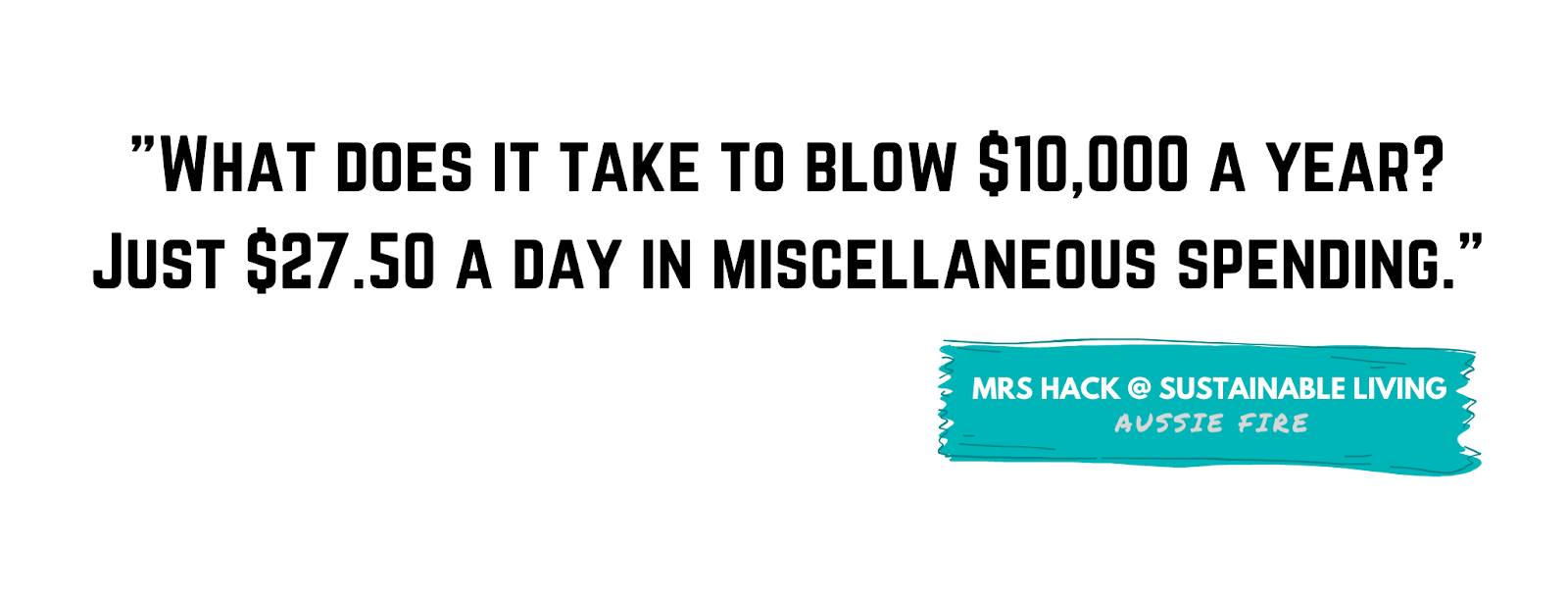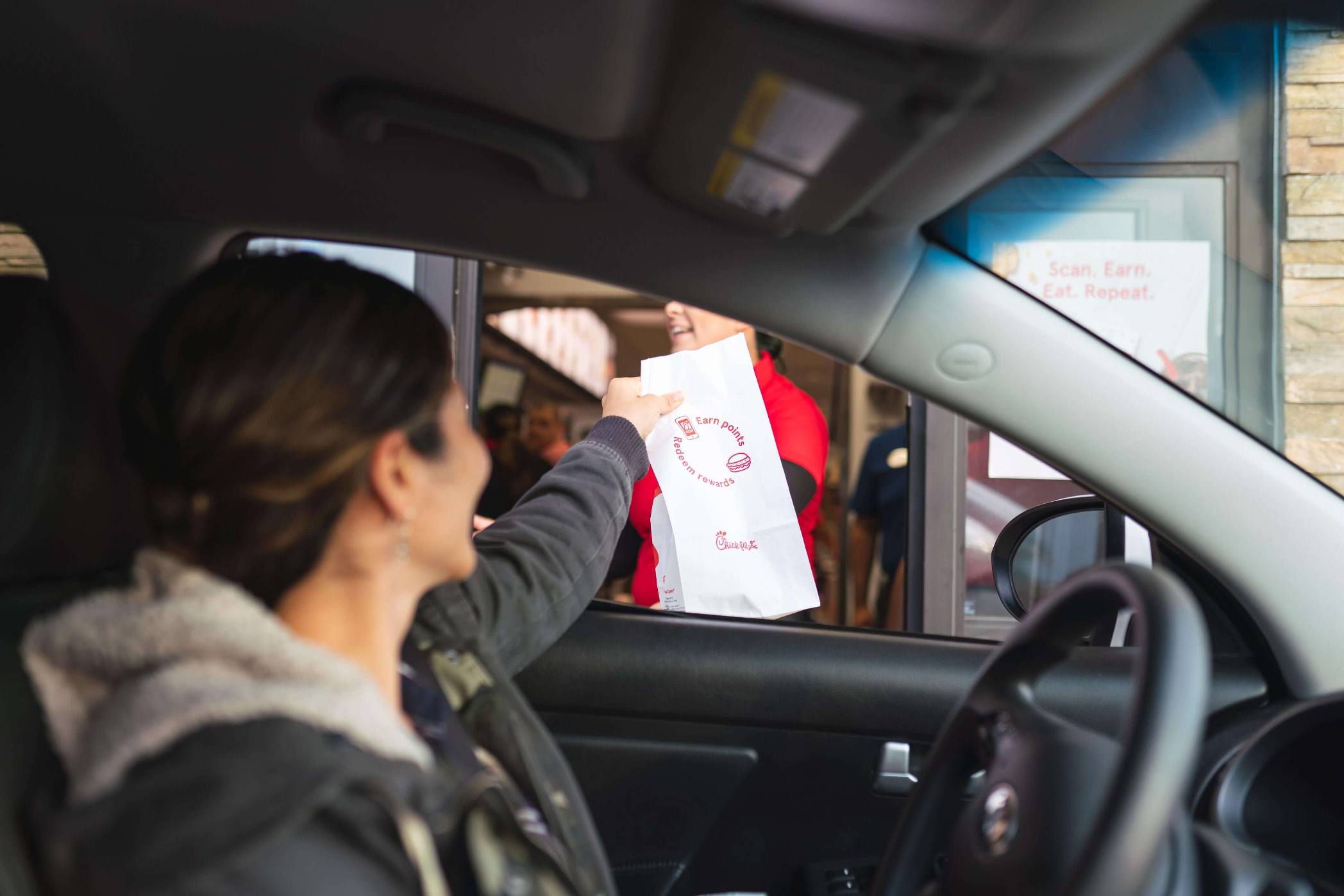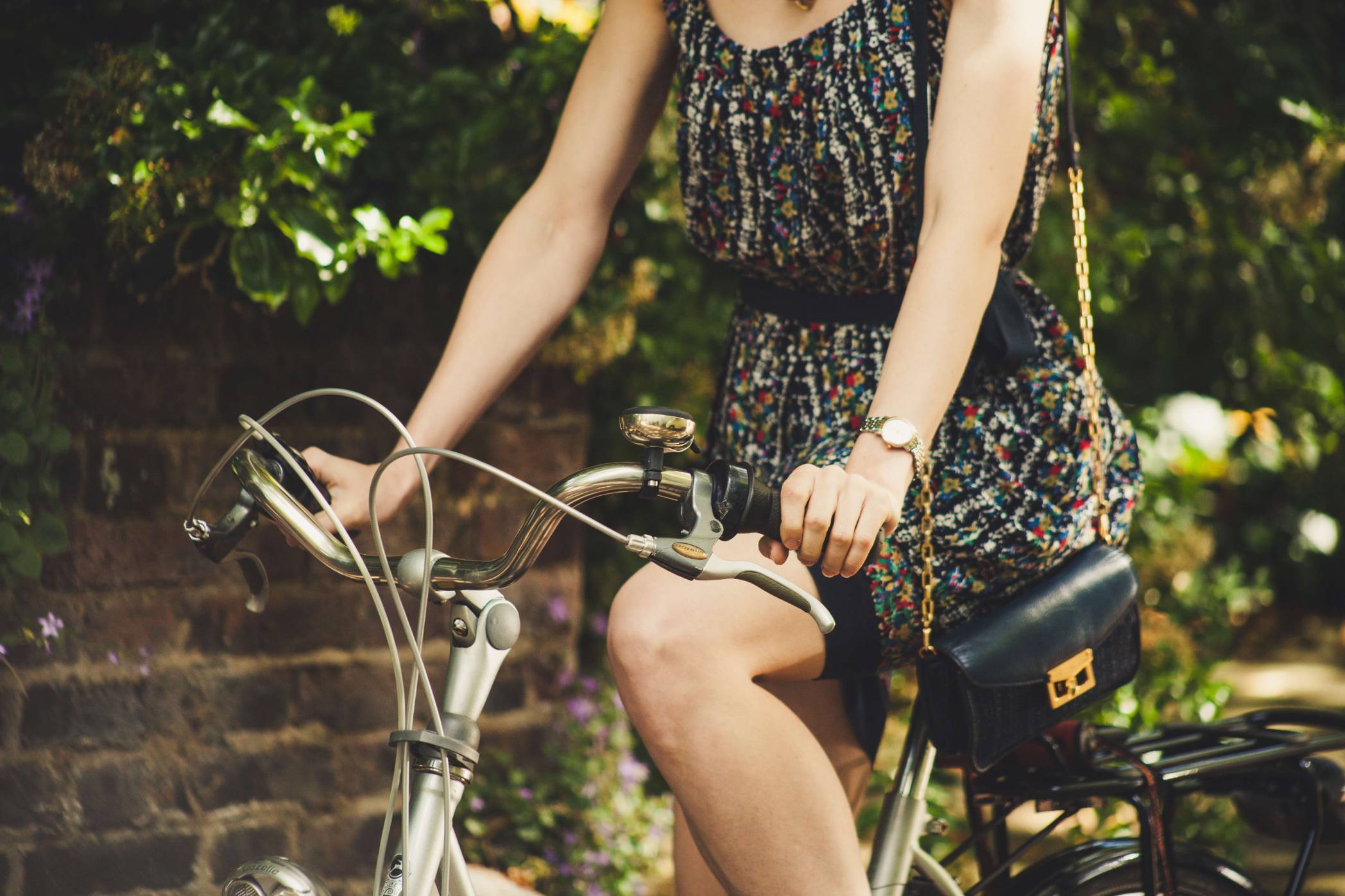What does it take to blow $10,000 a year?
Just $27.50 a day in miscellaneous spending.
Let me tell you a story of two people. They live in the same town. Both are married and have two children. As a family, each has the same combined income. Yet, one family is far wealthier than the other.

Wealth accumulation was not from winning the lottery or receiving an inheritance. It wasn’t due to socio-economic privilege, better education, or an amazing side hustle. It purely came down to life choices.
Our story begins by introducing the protagonists: Sally and Laura. They are both the heroes of their own journey. There is no overt enemy to give the tale a peak of excitement. The call to adventure is subdued, perhaps barely noticed by others. The approach to the story climax is slow, even simmering. There will be no bells and whistles to announce to the world a successful outcome. In fact, to the broader population, our true hero seems just like any other everyday person.
However, only one of our protagonists will reach the holy grail of reward. In this story the prize is financial sustainability. The other will wonder why they are always broke and life is a constant financial struggle, despite earning a decent income.
The day begins the same as every day for both Sally and Laura. The alarm on their smartphone wakes them in their respective houses at precisely 7 am. The children are already awake and can be heard arguing from their bedroom. Traffic noises hum past the houses as the birds delight in the new day with cheerful chirping.
Let us start our story with Sally. She rolls over in bed and checks she turned off the electric blanket last night. Her Google Nest gives her a rundown of the day ahead: the weather, the traffic, her scheduled workout at the local gym, and a reminder to book in her next hair colour at the salon.
She starts the day cursing. There’s been a traffic accident that’s blocked the fastest route to work. Time to get ready for work is now at a premium.
Sally goes to the kitchen and as a habit presses the remote control to enjoy her new purchase. She’s pleased she recently bought a TV on a payment plan through the store. They even gave her a bargain price on a new toaster, kettle, and sandwich press. She didn’t actually need to replace those items but they really gave the kitchen a lift.
Realising there’s no time to watch TV, Sally turns it off and selects a motivating track from Spotify using her phone and the Wi-Fi connected speakers. As her phone was a year old, she upgraded to the latest model on a 24 month plan which meant no upfront payment. All up it was only going to cost $80 per month.
Looking in the fridge, Sally notices they are out of ham. Toasties are out for this morning. Milk is in short supply too so that means no cereal. She makes a mental note to buy more Kellogg’s gluten-free cereal. Sally isn’t gluten intolerant; however, she did see an advertisement that told her why gluten-free was better for you.
To save time and due to the lack of food at home, Sally decides to buy breakfast for her and the kids on the way to school and work.
Yelling at the kids to hurry up, Sally quickly throws in their lunch boxes packets of chips, crackers, roll-ups, a container of jelly with a plastic spoon. Fruit, the kids need fruit. She grabs a little tub of peaches in juice for each of the kids. There’s no need to worry about packing her lunch as there’s a really nice café near the office and the staff knows her food preferences – it’s so much easier to buy lunch.
Sally and the kids rush to the car, mindful about having to go the long way this morning. It’s such a nuisance that the 3km journey is now going to be extended.
The car isn’t looking as clean as Sally would like so she decides that after work they’ll go through the car wash. It’s important to keep the car in good condition as she’s hoping to trade it in for a newer model soon. Her current car is still under finance but she’s not concerned. The car yard will come up with another loan arrangement for her. Maybe her husband could upgrade his car at the same time.

Grabbing their breakfast from the drive-through, Sally drops the kids off at school, gets to work, and scrambles for the coins to pay for car parking. It’s been such a stressful morning that Sally grabs a latte at the café (and a bottle of water for later). She then lights up a cigarette to help her relax on the way to the office.
As you can see, Sally’s morning is much is like the morning of most people. She does all the normal things like getting the kids to school and then going to work.
So let’s compare Sally’s morning to Laura’s morning and really focus on the differences.
Laura’s alarm on her phone wakes her up, just like Sally. Except Laura has an older phone that she paid around $200 cash, and her plan is prepaid. She gets all the same call, text and data allowances as Sally – but for $25 per month.
Sleep was deep and satisfying. The second-hand blankets her friend was going to throw out were not only warm but heavy and comforting as well (her friend was buying an electric blanket and didn’t need the woollen blankets any more).
Laura got up and flicked the power points on – there was no point wasting money on stand-by power when not using appliances. She turns on the radio she’s had since her teenage years and listens to the weather report. At that moment the boarder wakes up. She enjoys the company of another person in the house, plus his rent helps to cover the mortgage payment and bills.
The boarder, Laura and her husband talk about how much cheaper the power bill was last month after changing all the lights over to LEDs. This was on top of the noticeable difference in the electricity and gas bills from getting the best provider deal in their area.
Then Laura notices the kids have left the light on in their bedroom and reminds them, yet again, to turn lights off when they leave the room.
They all sit down to breakfast and enjoy eggs from the chickens, fresh bread made in a second-hand bread machine, and no name cereal. Laura doesn’t understand why people pay premium prices for brand name items when generic items taste just as good. Or why people buy expensive gluten-free food if it’s not a dietary requirement. It’s unusual to find ham in the house as they eat very little meat due to the cost. There’s plenty of quality fresh vegetarian produce available at a cheaper price.
Getting food ready for work and school has been streamlined. A large tray of slice was made on the weekend and frozen. Laura packs lunch boxes with frozen slice (which will defrost in time to eat), fresh fruit and cut up veggie sticks in a reusable container.
Lunch for the kids is usually a sandwich wrapped in a napkin and put into another reusable container. Water bottles are filled. Milky lattes for the adults are made on the stovetop and put into thermoses for later. Laura and her husband’s own lunches are dinner leftovers.
Bike helmets are grabbed, backpacks put on and the family head off on their bicycles. They have a family rule for any distance less than 5km that they should ride bikes – this not only saves them money but also provides free exercise.

Laura’s bike was a score. It was yet another discarded item left at the waste transfer station even though there was nothing wrong with it. Her husband got his bike for a bargain through a second-hand trading site.
Contrary to appearances, they do have a car for rainy days and long distances. It’s an older yet still reliable car they paid cash for many years ago. As the car is getting on in age and they don’t drive it much, it makes the insurance premiums cheaper. Also, there’s no car loan repayments.
The ride to school drop off and work was refreshing and invigorating. Laura heard on the radio about traffic delays due to a car accident. Whilst she felt empathy for those hurt, she was thankful that it didn’t affect her getting to work as she was riding her bike. Another bonus to riding was that Laura didn’t have to pay for parking on arrival at her job.
Walking to the office, she got her latte from her backpack and took a sip making sure to avoid the frazzled looking woman trying to smoke a cigarette and hold a plastic water bottle and disposable coffee cup all at the same time.
The differences in lifestyle choices between Sally and Laura are stark. Both trajectories have long-lasting financial and environmental impacts whether they be for good or bad. For example, whilst at work both women notice a small hole in their top. Sally is upset that her brand name clothing isn’t lasting and goes out to by another brand name top (she might even find some other new season clothing she would like to purchase). Meanwhile, Laura wonders if she has the coloured thread at home to repair the hole in her top before it gets any bigger. In this case, who is spending less money and who is creating less environmental waste?
Back to Sally, she’s now finished work for the day and drives 1km to do a quick workout at the local gym where she has a membership. She just adores her Nike bag and is considering buying protein powder.
Sally picks up the kids from after school care and realises she still needs to grab some breakfast items from the supermarket. Off she goes. Everyone is hungry by now so they impulse buy some snacks to get through to dinner time. The kids are complaining they’re thirsty and Sally gets them a bottle of fizzy drink each (she also gets another packet of cigarettes).
Arriving home, Sally checks the letterbox and puts the magazine she subscribes to in her bag. There are some bills there too that she’ll attend to later.
As she loads the groceries into the fridge, Sally notices a nasty smell. Searching through the fridge contents she discovers some food has gone bad. Oh well, it happens all the time and she throws the whole lot in the landfill bin.
Feeling exhausted, Sally decides to buy delivered pizza. She also orders a dessert. It wasn’t her intention to buy something sweet, however, the photo of it looked so good on their website when she was ordering.
Beyond tired, she collapses on the designer leather couch, turns on the TV yet can’t decide between watching Netflix or Stan, and wishes she could go on an overseas holiday. She turns to her husband and they talk about getting the limit on their credit card extended.
Now, over to Laura. Her workday is done and she rides her bike to her friend’s house. They have an arrangement where they look after each other’s kids. This arrangement doesn’t involve money. When she’s there she gets a text from the library that her favourite magazine is available to pick up – this is, of course, a free service. And then she notices an email about a bill to pay. Laura made sure all her bills were electronic to avoid paying the extra charges for paper bills.
The bill is for their house insurance. She’s happy with the amount as every year she shops around for the best deal and makes sure she gets the ‘new customer discount’.
Laura gets home and makes the kids a snack of homemade popcorn. It’s such an economical food to make as ¼ cup of kernels makes an enormous bowl of popcorn. She doesn’t use a popcorn machine, but instead a saucepan and lid.
Whilst the kids are having their snack, Laura does a quick workout at home using weights. Sometimes she gets onto YouTube and does a free workout.
As Laura’s family does meal planning and shops once a week, they don’t run out of food unnecessarily. This avoids going to the shop multiple times or impulse buying. They are also mindful not to waste food, and put whatever household rubbish they have into the right bins.
Because they did away with single-use items such as cling wrap, paper towel and tissues, they now have less waste. This had the flow-on effect of being able to get a smaller cheaper landfill bin from their local council.
After dinner, the adults crack open a homemade cider. Laura quickly mends the hole in her top, whilst her husband starts watching a new series on catch-up TV (a free service).
They turn to each other to discuss where to go for their next holiday. In summer, they camped at a national park at the beach. Maybe for the autumn break, they could go back to that campsite by a large lake in the mountains. Their camping trips are so cheap they have no need to put it on a credit card. In fact, they don’t have a credit card at all.
As Laura and her husband go to bed, they turn off appliances at the power point and snuggle under their heavy blankets to keep warm.
Now our two protagonists are fast asleep, who do you think is the true hero of our story? If the Holy Grail is the reward of financial sustainability, is it Sally or Laura who earns the cup?
Let’s look at all the ways Sally and her family spend money and ask yourself – was it really necessary? Did it improve her life? Was she able to save and invest money? How does it impact the environment?
Here’s the rundown of Sally’s expenses for the day: there’s debt for new appliances, the car loan and credit card; they buy processed packaged food, take away food and drinks; there’s no meal planning; groceries are brand name, fad foods and impulse purchases; she has the latest technology at premium prices; they take the car for short distances and pay for car washing and parking; there’s a gym membership and regular expensive hairdresser appointments; plus, designer furniture, cigarettes and holidays on credit. Oh, did I mention the subscription services of Spotify, Netflix, Stan and magazines…
Hmmm, so far our protagonist is not doing so well. Even if Sally and her husband stopped wasting money, could they do even better?
Back to Laura. What is Laura doing that Sally is not? Apart from everything previously listed, THERE’S MORE.
Laura doesn’t waste money on standby power, costly plans with electricity, gas or insurance providers; bills are all received electronically to avoid extra fees; they use low wattage items like light globes; their appliances are either good quality older items or second hand; they don’t need the latest technology or expensive phone plans; whenever possible they ride bikes rather than drive; their holidays are within their budgeted means; they repair items, rather than throw away and buy new; single-use items are rarely purchased; they eat little meat, opting for a more vegetarian diet; and, they have a boarder whose rent helps to pay the mortgage and bills.
So, what does it take to blow $10,000 a year? Just $27.50 a day in miscellaneous spending. Without a doubt, Sally blows more than $27.50 a day.
Would you rather be like Sally or Laura?
About Mrs Hack from Sustainable Living | sustainable-living.blog
Sustainable Living is a website dedicated to eco-friendly and frugal living as a path to financial independence. Mrs Hack, aka @CashHippyAU, is a school teacher, mum to six children and lives in NE Victoria. She’s also what you’d call a ‘late starter’ to FI. Living frugally, saving and investing is what is going to save her and her husband from being broke pensioners, and instead be absolutely fabulous self-funded retirees when they decide they are ready to retire.
NOTE: Aussie FIRE is a free educational resource prepared by Pearler, with permission from the co-authors. At Pearler, we strive to make investing for your long term goals easier and fun, but we only provide general information and/or general advice. We don’t present you any options based on your personal objectives, circumstances, or financial needs. Any advice is of a general nature only. All investments carry risk. Before making any investment decision, please consider if it’s right for you and seek appropriate taxation and legal advice. Please view our Financial Services Guide before deciding to use or invest on Pearler.


